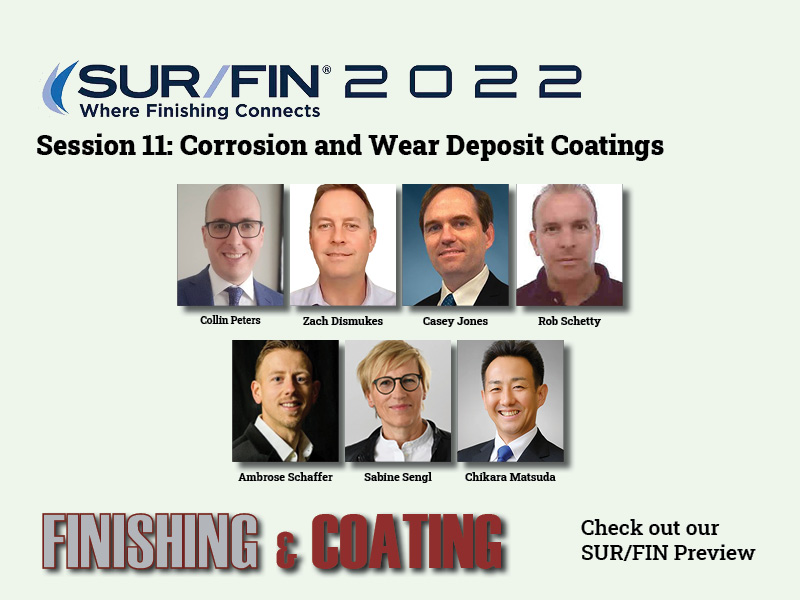Session 11 at the NASF SUR/FIN Technical Conference will be on “Corrosion and Wear Deposit Coatings.”
Here are the abstracts for the presentations on June 8. Please visit www.nasfsurfin.com for information on registering for the event:
Session 11: Corrosion and Wear Deposit Coatings
Session Chairs Caleb Morrison, Atotech USA, and Adam Blakeley, MacDermid Enthone
1:30 – 2:00: A New Level of Corrosion Resistant High-P Electroless Nickel — Collin Peters, Atotech
 Collin PetersElectroless deposition of the nickel phosphorus alloy coatings (electroless Ni-P) has been widely used in many industrial applications for the unique properties such as corrosion resistance, wear resistance, non-magnetism, improved micro-hardness and coating thickness uniformity. Because of its amorphous nature and passivity, the corrosion resistance of the coatings, especially of the high–P EN >10.5% P, are excellent and in many environments are superior of that of pure nickel or chromium alloys. Toxic heavy metals have been historically used as stabilizers and brighteners in electroless nickel processes but in the last years the worldwide regulations became very restrictive regarding their use. The newest generation of high–P EN processes use unique stabilizers with improved coating properties; specifically corrosion resistance. Process and coating properties like deposition rate, P–content, internal stress, tribological properties as well as their corrosion resistance are highlighted.
Collin PetersElectroless deposition of the nickel phosphorus alloy coatings (electroless Ni-P) has been widely used in many industrial applications for the unique properties such as corrosion resistance, wear resistance, non-magnetism, improved micro-hardness and coating thickness uniformity. Because of its amorphous nature and passivity, the corrosion resistance of the coatings, especially of the high–P EN >10.5% P, are excellent and in many environments are superior of that of pure nickel or chromium alloys. Toxic heavy metals have been historically used as stabilizers and brighteners in electroless nickel processes but in the last years the worldwide regulations became very restrictive regarding their use. The newest generation of high–P EN processes use unique stabilizers with improved coating properties; specifically corrosion resistance. Process and coating properties like deposition rate, P–content, internal stress, tribological properties as well as their corrosion resistance are highlighted.
2:00 – 2:30: XRF for Conversion Coating Thickness Measurement — Zach Dismukes, Bowman XRF
 Zach DismukesXRF is a widely accepted non-destructive tool for measuring the thickness and composition of basically any type of metal coating. Typical measurable thickness ranges are on the order of 1-1000 microinches, or .03-25 microns. Recent improvements in detector technology have improved detection limits and consequently lowered the thickness range measurable for very thin coatings. Many metal finishers work with chromate and phosphate type conversion coatings, with alternatives based on zirconium (Zr) and titanium (Ti) becoming more popular over the last decade. All of these coatings are very thin and very difficult to measure with older XRF technology. Bowman has optimized their XRF systems for maximum sensitivity for measuring conversion coatings with great accuracy and precision. This is possible with the latest in silicon drift detector (SDD) technology which comes standard with every Bowman model. With the ability to focus the x-ray tube with micro-spot precision, small or complex sample geometries can be easily measured. Alternatively, larger samples or Q-panels can be scanned in multi-point programs using the automated sample stage to test for coating uniformity. Different equipment options and performance data from conversion coating application studies will be presented and discussed.
Zach DismukesXRF is a widely accepted non-destructive tool for measuring the thickness and composition of basically any type of metal coating. Typical measurable thickness ranges are on the order of 1-1000 microinches, or .03-25 microns. Recent improvements in detector technology have improved detection limits and consequently lowered the thickness range measurable for very thin coatings. Many metal finishers work with chromate and phosphate type conversion coatings, with alternatives based on zirconium (Zr) and titanium (Ti) becoming more popular over the last decade. All of these coatings are very thin and very difficult to measure with older XRF technology. Bowman has optimized their XRF systems for maximum sensitivity for measuring conversion coatings with great accuracy and precision. This is possible with the latest in silicon drift detector (SDD) technology which comes standard with every Bowman model. With the ability to focus the x-ray tube with micro-spot precision, small or complex sample geometries can be easily measured. Alternatively, larger samples or Q-panels can be scanned in multi-point programs using the automated sample stage to test for coating uniformity. Different equipment options and performance data from conversion coating application studies will be presented and discussed.
2:30 – 3:00: Corrosion and Wear Resistant Cold Spray Coating for Dimensional Restoration — Casey Jones, Engineering and Software System Solutions
 Casey JonesAircraft structure and components are commonly found with corrosion, wear, tooling, in-service damage in many areas across the aircraft requiring local damage clean-up or corrosion removal, and application of a wear coating and/or a Corrosion Preventative Compound (CPC) applications to prevent further corrosion. For these corrosion and wear repair scenarios, in some cases there are no practical repair methods to remove corrosion products and dimensionally restore these aircraft components in a relatively quick manner. Therefore, there is a need to develop a corrosion and / or wear resistant cold spray process that is portable and can provide quick corrosion removal and on-site dimensional restoration for depot and field level sites. Cold spray is thermal spray process; however, unlike traditional thermal spray processes for wear resistant coating applications, the process operates at lower temperatures and the powder remains below the melting point and bonds by particle deformation due to the kinetic energy upon impact. The cold spray process is also much simpler and only uses helium, nitrogen, or compressed air as a carrier gas to accelerate the particles to the critical velocity required for bonding. ES3 has developed cold spray repair processes to replace inadequate CPC applications and expensive and inefficient particle deposition legacy processes for the US Air Force, Navy and Army. The results have been exceptional and as a result of ES3’s groundbreaking research, various cold spray coatings, including chrome replacement, can be efficiently deposited, providing excellent wear and corrosion resistance.
Casey JonesAircraft structure and components are commonly found with corrosion, wear, tooling, in-service damage in many areas across the aircraft requiring local damage clean-up or corrosion removal, and application of a wear coating and/or a Corrosion Preventative Compound (CPC) applications to prevent further corrosion. For these corrosion and wear repair scenarios, in some cases there are no practical repair methods to remove corrosion products and dimensionally restore these aircraft components in a relatively quick manner. Therefore, there is a need to develop a corrosion and / or wear resistant cold spray process that is portable and can provide quick corrosion removal and on-site dimensional restoration for depot and field level sites. Cold spray is thermal spray process; however, unlike traditional thermal spray processes for wear resistant coating applications, the process operates at lower temperatures and the powder remains below the melting point and bonds by particle deformation due to the kinetic energy upon impact. The cold spray process is also much simpler and only uses helium, nitrogen, or compressed air as a carrier gas to accelerate the particles to the critical velocity required for bonding. ES3 has developed cold spray repair processes to replace inadequate CPC applications and expensive and inefficient particle deposition legacy processes for the US Air Force, Navy and Army. The results have been exceptional and as a result of ES3’s groundbreaking research, various cold spray coatings, including chrome replacement, can be efficiently deposited, providing excellent wear and corrosion resistance.
3:00 – 3:30: Electrolytic Nickel-Phosphorous Alloy Deposition with High (≥10%) Phosphorous Content — Rob Schetty, Technic
 Rob SchettyDriving forces of green technology, value generation, and advanced applications in emerging technologies are rapidly changing the technical requirements for electronics finishing. Deposition of nickel-phosphorous (NiP) alloys has been done electrolytically for decades, with these deposits generally categorized as low-phos (1-4%P) or mid-phos (5-8%). In electronics surface finishing applications, NiP deposits containing >10% P are desirable for a variety of reasons: (i) improved corrosion resistance / enhanced functionality as a barrier layer; (ii) low/no magnetic properties, particularly for high frequency (5G) applications. Historically, it has been extremely difficult/impossible to produce high-phosphorous (>10% P) containing NiP deposits, especially at the high current densities required for high volume production using high speed reel-to-reel plating mode. This paper will introduce a newly developed process capable of producing high-phos (>10% P) deposits at high current densities from a boric-acid free electrolyte. Data will be presented for both the corrosion resistant barrier layer application and the non-magnetic application, from both laboratory studies and production environments.
Rob SchettyDriving forces of green technology, value generation, and advanced applications in emerging technologies are rapidly changing the technical requirements for electronics finishing. Deposition of nickel-phosphorous (NiP) alloys has been done electrolytically for decades, with these deposits generally categorized as low-phos (1-4%P) or mid-phos (5-8%). In electronics surface finishing applications, NiP deposits containing >10% P are desirable for a variety of reasons: (i) improved corrosion resistance / enhanced functionality as a barrier layer; (ii) low/no magnetic properties, particularly for high frequency (5G) applications. Historically, it has been extremely difficult/impossible to produce high-phosphorous (>10% P) containing NiP deposits, especially at the high current densities required for high volume production using high speed reel-to-reel plating mode. This paper will introduce a newly developed process capable of producing high-phos (>10% P) deposits at high current densities from a boric-acid free electrolyte. Data will be presented for both the corrosion resistant barrier layer application and the non-magnetic application, from both laboratory studies and production environments.
3:30 – 4:00: Continuous Steady State Operations of Electroless Nickel Systems — Ambrose Schaffer, MacDermid-Enthone
 Ambrose SchafferUnlike most commercially available electrolytic processes, electroless nickel solutions have a finite operating life which is due in large part to reaction by-product build up in the solution. Consequently the “age“ of an electroless bath can be characterized by the concentration of these by-products. As these species build in concentration not only can the operation of the plating bath be affected, but more importantly the properties of the deposit can change quite dramatically. Some applications that use electroless nickel require very specific deposit properties and therefore require a narrow window of operating age which can be challenging for applicators to meet. This presentation will serve to illustrate techniques and technologies that can be used to operate an electroless nickel solution virtually indefinitely at a very specific and targeted age of solution. This can help applicators improve deposit quality and consistency and improve yields. Two specific techniques will be compared and contrasted and the advantages and disadvantages of both will be characterized.
Ambrose SchafferUnlike most commercially available electrolytic processes, electroless nickel solutions have a finite operating life which is due in large part to reaction by-product build up in the solution. Consequently the “age“ of an electroless bath can be characterized by the concentration of these by-products. As these species build in concentration not only can the operation of the plating bath be affected, but more importantly the properties of the deposit can change quite dramatically. Some applications that use electroless nickel require very specific deposit properties and therefore require a narrow window of operating age which can be challenging for applicators to meet. This presentation will serve to illustrate techniques and technologies that can be used to operate an electroless nickel solution virtually indefinitely at a very specific and targeted age of solution. This can help applicators improve deposit quality and consistency and improve yields. Two specific techniques will be compared and contrasted and the advantages and disadvantages of both will be characterized.
4:00 – 4:30: Agriculture and the Stricter Demands for Increased Corrosion Resistance — Sabine Sengl, Atotech
 Sabine SenglApplications in the field of Agricultural Industry have always been demanding in matters of corrosion protection; especially after Chromates have been phased out. The influence of the different outside climates all around the year together with tough abrasive environments and the challenging chemical attack through fertilizers such as UAN (Urea Ammonium Nitrate) are requiring a reliable state of the art surface protection. This presentation will summarize the general requirements of the agricultural demands and will highlight the latest developments of combined electrolytic plating like Zinc or Zinc Nickel in combination with Zinc Flake based finishes. This includes bulk parts as fasteners up to large complex shaped rack spin parts and its performance of cathodic corrosion protection in this extreme environment. Dedicated performance examples including data of improved chemical or abrasion resistance will be explained and shared with the audience.
Sabine SenglApplications in the field of Agricultural Industry have always been demanding in matters of corrosion protection; especially after Chromates have been phased out. The influence of the different outside climates all around the year together with tough abrasive environments and the challenging chemical attack through fertilizers such as UAN (Urea Ammonium Nitrate) are requiring a reliable state of the art surface protection. This presentation will summarize the general requirements of the agricultural demands and will highlight the latest developments of combined electrolytic plating like Zinc or Zinc Nickel in combination with Zinc Flake based finishes. This includes bulk parts as fasteners up to large complex shaped rack spin parts and its performance of cathodic corrosion protection in this extreme environment. Dedicated performance examples including data of improved chemical or abrasion resistance will be explained and shared with the audience.
4:30 – 5:00: Properties of PVD-Deposited Chromium Oxide Films to Solve Mold Die Problems in Plastic Molding — Chikara Matsuda, Yuken Industry
Plastic molding is an indispensable method for the mass production of industrial products. Plastic-molded products are extensively used in daily life, such as for plastic water bottles and a variety of cases and containers. They are also widely utilized in automobiles, airplanes, machining tools, and electronics. In recent years, in light of climate change, many countries have been promoting the weight reduction of automobiles, and some automobile parts materials have been replaced by lighter metals and plastics. For parts requiring strength and heat resistance, including engine parts such as water pumps and intake manifolds, engineering plastics such as POM, PA and PBT and super-engineering plastics like PPS and PEEK are used instead of standard plastics. In addition to cutting to make parts, there are other mass production methods such as stamping and plastic molding using dies. Dies and molds are generally made of high-strength steel called die/mold steel. When processing metal materials like iron and aluminum, the surface of the die/mold is coated with a very hard film to prevent wear. On the other hand, the surface of molds/dies for plastic molding rarely wears, except when a hard filler such as glass is added to the plastic material. Still, there are other problems that can occur besides wear, such as corrosion, gas (deposit) adhesion, and mold release failures. Such problems can result in a decrease in productivity and degradation of product quality. We will report on the characteristics of chromium oxide films deposited by physical vapor deposition (PVD) in a vacuum chamber, where the raw material metal is ionized and deposited on an object such as a die. We will also present some case studies where such chromium oxide films resolved the issues described above.



































